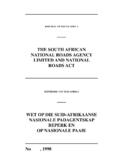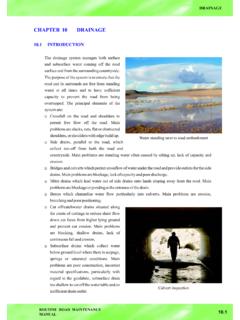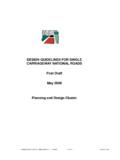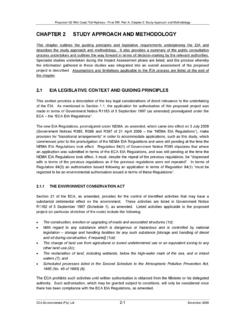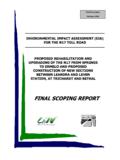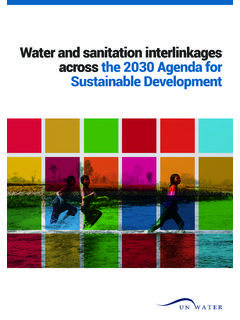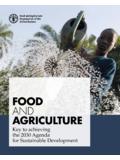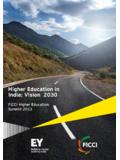Transcription of 2030 - SANRAL
1 SUMMARYHORIZON 2030 STRATEGY SANRALOur purpose is to deliver a safe, efficient, reliable and resilient national road transport system for the benefit of all the people of South SANRAL STRATEGY | HORIZON 2030 CONTENTSOUR JOURNEY 4 | STRATEGIC RESPONSE 5 STRATEGIC CONTEXT 8 | CHALLENGES 11 STRATEGIC OPPORTUNITIES 12 | TEN STRATEGIC OBJECTIVES 13 ROAD NETWORK MANAGEMENT 14 | PILLARS 16 ENABLERS 183 SUMMARYThe National Development Plan aims to reduce inequality and eliminate poverty by 2030. These goals can be achieved by drawing on the energies of South Africa s people, growing an inclusive economy, building partnerships throughout society and enhancing the capacity of the SANRAL 2030 Strategy also known as Horizon 2030 recognises the contribution a state-owned entity such as SANRAL can make to build a capable and developmental state, and drive economic development through the provision and maintenance of critical future challenge is to manage the road network.
2 The primary road network is an important catalyst for economic growth but insufficient maintenance of existing infrastructure and inadequate investment in future capital projects can inhibit South Africa s future growth s strategy is a pro-active response to deliver on SANRAL s vision of a national transport system that delivers a better South Africa for all. It sets out in great detail SANRAL s strategic objectives, the four pillars of Roads, Road Safety, Stakeholders and Mobility, and the critical enablers that will make it possible for SANRAL to remain a respected, dynamic and responsive organisation over the next 13 is presenting a new vision, mission and strategy that will guide the organisation over the next stage in its growth to continue to plan, develop and manage South Africa s national road decades after its establishment, the South African National Roads Agency SOC Ltd ( SANRAL ) has re-examined its core values and strategy to take stock of the environment and determine how it can further improve on the delivery of its mandate.
3 This process is taking place within a rapidly changing global and regional economic environment, sweeping changes in technology and fundamental reassessments of South Africa s socio-economic priorities. SANRAL s new long-term vision and perspective acknowledges the major success areas of the past 19 years and seeks to build on them. It also reviews areas where the performance was sub-optimal to ensure the necessary interventions are made to correct them and ensure success. Since its establishment SANRAL has steadily grown the size of the national road network, primarily to improve connectivity between the cities of South Africa and across the region. This has contributed to mobility, supported economic growth objectives, provided access to opportunities for communities and supported the expansion of the commercial, agriculture and tourism sectors. SANRAL intends to build on its legacy of delivering state-of-the-art, high quality road infrastructure while also ensuring that its vision and mandate align with other key government programmes for socio-economic A BETTER SOUTH AFRICA THROUGH BETTER ROADSMANDATETo manage and control the national road network and take charge, among others, of the development, maintenance and rehabilitation of national roads within the framework of government our national road transport system delivers a better South Africa for SANRAL STRATEGY | HORIZON 2030 From its establishment in 1998 SANRAL followed a clear journey based on the prevailing strategic objectives and priorities.
4 SANRAL s growth and evolution in each of the respective ten-year periods required a focus on various strategic imperatives in response to the relevant challenges and started off from humble beginnings with a focus on growth but the first decade also included initial exposures to private finance and engineering excellence. The second decade was dominated by the reputational effects of the e-toll project public resistance, public trust challenges and pressures for inclusivity by a society desperate to participate meaningfully in the economy. The third and coming decade, will see a focus on long-term visioning, a review of network growth, a review of the SANRAL mandate, emphasis on relevance and concerted steps to deal with fair access to opportunities and redress of past 2010 Road network growth Introduction of private finance Accelerated infrastructure investment Construction of the regional trunk routes Technical excellence Support to other roads authorities1998-20102010-2020 MTSF 2014 / MTSF 2019 Road network growth E-toll project and uncertainty of toll funding model Reduction in public funding due to economic slowdown SANRAL reputation and public trust challenges Leadership transition2020-2030 HORIZON 2030 Focus on long-term visioning Review of network growth Review of funding model Long-term roads plan Review of SANRAL mandate Review of roads authority support model Emphasis on relevance Aggressive transformation agenda5 SUMMARYH orizon 2030 is presented against the background of
5 Important changes in both the local, regional and global environments and SANRAL s responses to these dynamic S STRATEGIC RESPONSEThe redefinition of South Africa s medium- and long-term objectives as set out in government strategies such as the National Development Plan 2030, the Medium Term Strategic Framework and the National Infrastructure PlanThe changing role and mandates of state-owned entities such as SANRAL in building a capable public sectorWide-ranging reflection and public debates on future funding models for road infrastructure and how to find a workable model that combines funding from the fiscus with the user-pay principle advocated in the National Development PlanWorking within the constraints of competing socio-economic priorities and limited funding from the fiscus to develop models that balance the need for world-class road infrastructure with the public s ability to payA growing realisation that transport planning is inextricably linked to spatial planning and that the management of the country s national road network must be aligned with broader strategies related to urbanisation.
6 Densification and the roll-out of public transport systemsThe elevation of road safety as a national priority and the identification of a clearly defined role for SANRAL to provide both safe roads and infrastructure and play a prominent role in road safety education and awarenessHarnessing the power of emerging technologies in the fields of engineering, construction, information and communication to deliver more effective road solutions and higher levels of safety and efficiencyThe transformation of the South African construction and engineering sectors and SANRAL s contribution to broad-based black economic empowerment, skills development and the growth of small- and medium-sized enterprisesThe growing integration of the Southern African region and the entire continent and role of road infrastructure to facilitate the free movement of people, goods and services and increase trade and investmentThe balancing of strategic economic infrastructure such as roads with the need to protect the environment and conserve South Africa s natural and cultural heritageRemaining on the leading edge of global trends in environmental management, energy efficiency and the utilisation of renewable resourcesStrengthening SANRAL s role within communities through pro-active consultation, partnerships and inclusive decision-makingMeeting high standards of corporate governance, ethics and adherence to sound procurement and supply chain management processesMaximising the return on SANRAL s assets to generate alternative funding sources and explore opportunities to commercialise its services as part of its integrated funding strategyChanging SANRAL s own organisation through a renewed focus on transformation, inclusivity.
7 Leadership and skills development and succession SANRAL STRATEGY | HORIZON 2030 SANRAL S DEVELOPMENT19351948197219741986198819941 99619981999200620132017 The National Roads Act was promulgated establishing the National Roads Board (NRB) and the National Road Fund (NRF).Ring-fencing of fuel levy for road funding was replaced by the South African Roads Infrastructure Strategic Framework for South Africa (RISFSA) Transport Master Plan or Natmap 2050 adopted by strategic framework published called the national Land Transport Strategic Framework (NLTSF).SA transitions from apartheid to democracy and majority Paper on National Transport Policy established managing 7 200km of national strategic framework developed called Moving South Africa that provides an action agenda for delivery on the country s primary transport abolished and replaced with National Transport Commission (NTC).
8 New National Roads Act in NRF income due to apartheid government s fuel coservation SANRALSANRAL is a state-owned entity with the Minister of Transport as its sole shareholder. It was established in 1998 under its own founding legislation (Act 7 of 1998) and is tasked with financing, developing, controlling, planning, maintaining and rehabilitating national roads within the framework of government is repurposing itself because South Africa has embarked on a process of fundamental transformation that opens the path for inclusive, broad-based economic development. This transformation will promote growth, mobilise investment, create jobs and empower recognises that it can help to build a capable and developmental state, and drive economic development through the provision and maintenance of critical SANRAL STRATEGY | HORIZON 2030 STRATEGIC CONTEXTNATIONAL DEVELOPMENT PLAN 2030 The NDP provides a broad framework for South Africa s future growth trajectory.
9 With the theme Our future make it work the aims of the NDP are to eliminate poverty and reduce inequality by can be achieved by uniting South Africans, unleashing the energies of its citizens, growing an inclusive economy and enhancing the capability of the National Development Plan refers to the country s road network as South Africa s largest single public asset .. National and provincial roads are the prime means of connecting people and moving cargo from small settlements and secondary towns to the centres of economic activity. At a replacement value of trillion, preserving it is a top priority. MEDIUM TERM STRATEGIC FRAMEWORKThe MTSF recognises the need for a capable and developmental state and highlights its contribution to address infrastructure constraints. State-owned entities, such as SANRAL , must play a critical role in driving economic development through building and maintaining economic Africa has a relatively good core national network of economic infrastructure but there is a challenge to maintain and expand it to address the demands of a growing economy.
10 The economy has already been constrained by inadequate investment and ineffective operation and maintenance of existing infrastructure such as the national road network is a precondition for providing basic services such as electricity, water, sanitation, telecommunications and public transport, and it needs to be robust and extensive enough to meet industrial, commercial and household POLICYAs shown by Graph 1, since inception SANRAL has grown its annual non-toll allocation from the fiscus in tandem with the size of its network. Public funds are a critical source of funding and enable SANRAL to undertake a significant amount of work on the network. However, the introduction of private finance in the form of state tolls and public-private-partnerships has proved valuable for SANRAL and allowed it to broaden the extent of the funding envelope and achieve more than it could were it only reliant on the non-toll fiscal this key alternative source of funding, SANRAL would not have been able to carry out some of the major works that include expansion of the network, greenfield developments and brownfield upgrades.
